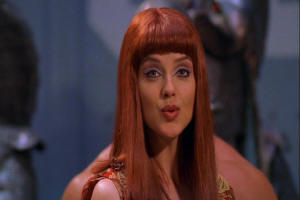
Hathor
|
| Egyptian cow goddess. Daughter of Nut and Re. In early Egyptian mythology she was the mother of the sky god Horus, but was later replaced in this capacity by Isis. Hathor then became a protectress of Horus. She was
depicted either as a cow or in human form wearing a crown consisting of a sun disk held between the horns of a cow. Her name appears to mean "house of Horus", referring to her role as a sky goddess, the "house" denoting the heavens depicted as a great
cow. Hathor was often regarded as the mother of the Egyptian pharaoh, who styled himself the "son of Hathor". Since the pharaoh was also considered to be Horus as the son of Isis, it might be surmised that this had its origin when Horus was considered to
be the son of Hathor. Hathor took on an uncharacteristically destructive aspect in the legend of the Eye of Re. According to this legend, Re sent the Eye of Re in the form of Hathor to destroy humanity, believing that they were plotting aganist
him. However, Re changed his mind and flooded the fields with beer, dyed red to look like blood. Hathor stopped to drink the beer, and, having become intoxicated, never carried out her deadly mission. Hathor was often symbolized by the papyrus reed, the
snake, and the Egyptian rattle known as the sistrum. Her image could also be used to form the capitals of columns in Egyptian architecture. Her principal sanctuary was at Dandarah, where her cult had its early focus, and where it may have had its origin.
At Dandarah, she was particularly worshipped in her role as a goddess of fertility, of women, and of childbirth. At Thebes she was regarded as a goddess of the dead under the title of the "Lady of the West", associated with the sun god Re on his descent
below the western horizon. The Greeks identified Hathor with Aphrodite. |
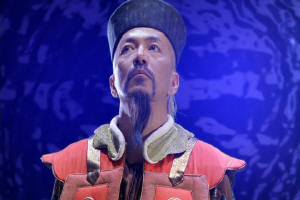
Yu |
|
On Earth, Yu was a Chinese emperor. He is a powerful System Lord and represented the Goa'uld with Cronos and Nyerti at the SGC during the Goa'uld-Asgard negotiations with Earth. He was the leader of
the Goa'ulds present and agreed to include Earth in a non-aggression treaty after SG-1 had saved Cronos from injuries inflicted by Nyerti.
|
|
|
|
|
|
|
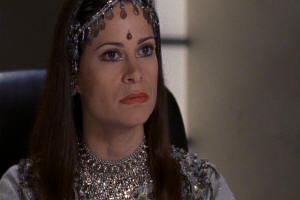
Nyerti |
|
Nyerti is a self-serving System Lord who impersonates the ancient Hindu goddess of darkness. She attempted to destroy the
SGC by implanting a naquadah-based bomb inside Cassandra, the lone survivor of an engineered disease on Hanka, P8X-987.
Nyerti represented the System Lords during the Goa'uld-Asgard negotiations at the SGC. She made an attempt on the life of
fellow System Lord Cronos, trying to place the blame on Teal'c (whose father was killed by Cronos). She was discovered, in
spite of her stealth technology, and taken away to be punished by the other System Lords.
|
|
|
|
|
|
|
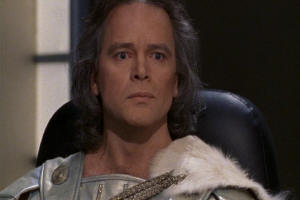
Cronus |
| The third member (with his parents Amen and Mut) of the great triad of Thebes. Khons was the god of the moon. The best-known story about him tells of him playing the ancient game senet ("passage") against Thoth, and
wagering a portion of his light. Thoth won, and because of losing some of his light, Khons cannot show his whole glory for the entire month, but must wax and wane. The main temple in the enclosure at Karnak is dedicated to him. |
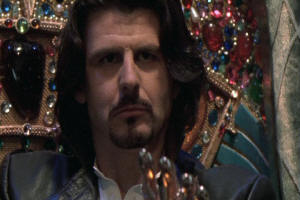
Seth |
| (Seth, Setekh, Setesh, Seti, Sutekh, Setech, Sutech) Egyptian god of chaos who embodied the principle of hostility if not of outright evil. He was associated with foreign lands
and was the adversary of the god Osiris. Seth was usually depicted in human form with a head of indeterminate origin, though said to resemble that of an aardvark. He had a curved snout, erect square- tipped ears and a long forked tail. Sometimes he was
represented in entirely animal form with a body similar to that of a greyhound. He was said to be the son either of Nut and Geb or of Nut and Ra, and the brother of Isis, Osiris and Nephthys. Nephthys was sometimes given as his consort, although he is
more commonly associated with the foreign, Semitic goddesses Astarte and Anat. Despite his reputation, he had an important sanctuary at Ombos in Upper Egypt, his reputed birthplace, and had his cult was also prominent in the north-eastern region of the
Nile delta. For a time during the third millenium BC, Seth replaced Horus as the tutelary deity of the pharaohs. However, the story of Seth's murder of Osiris and subsequent war with Horus gained currency and Horus was restored to his original
status. The war with Horus lasted eighty years, during which Seth tore out the left eye his adversary and Horus tore out Seth's foreleg and testicles. Horus eventually emerged victorious, or was deemed the victor by a council of the gods, and thus became
the rightful ruler of the kingdoms of both Upper and Lower Egypt. Seth was forced to return the eye of Horus and was himself either castrated or, in some versions, killed. In some versions Seth then went to live with the sun god Re, where he became the
voice of the thunder. In the Book of the Dead Seth was referred to as the "lord of the northern sky" and held responsible for storms and cloudy weather. Seth protected Re during his night voyage through the underworld against the Apophis-snake. On the
other hand, Seth was a peril for ordinary Egyptians in the underworld, where he was said seize the souls of the unwary. Among the animals sacred to Seth were the desert oryx, crocodile, boar, and the hippopotamus in its aspect as a destroyer of boats and
of planted fields. The pig was a taboo in Seth's cult. The Greeks later equated Seth with their demon-god Typhon. |

Apophis |
| Apophis (Egyptian Apep) was the great adversary of the sun god, Re. and was the very embodiment of the powers of dissolution, darkness and non-being. Hence, he was a sort of void or "black hole" forcing those he swallowed into that non-existence
which the Egyptians feared so greatly. Being completely outside of the natural world, he was believed to require no nourishment other than to "breathe" his own shouts. He was a huge serpent who was thought to have existed at the beginning of time in the
waters of primeval chaos prior to creation and his power was so great that it was thought that he would continue to exist in an endlessly malevolent cycle of attack, defeat and resurgent attack. He is thus known by many epithets, ranging from evil
lizard, opponent and enemy to world encircler and serpent of rebirth. |
 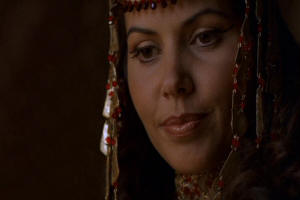 |
|
Amaunet Previous host
Amaunet |
| A goddess whose name means 'hidden one' and whose shadow, among the primeval gods, is a symbol of protection. A deity at Karnak temple at least since the reign of Sesostris I (Dynasty XII), she is predominantly the consort of Amun playing,
however, a less prolific role than his other wife Mut. A statue datable to Tutankhamun's reign which was set up in the Record Hall of Tuthmosis III at Karnak shows the goddess in human form wearing the Red Crown of the Delta. Reliefs at Karnak clearly
mark her as prominent in rituals closely associated with the monarch's accession and jubilee festival. For instance, in the monument of Tuthmosis III, known as the Akh-menu, Amaunet and Min lead a row of deities to watch the king and sacred bull in the
jubilee celebration. Much later in the Greek domination of Egypt she is carved on the exterior wall of the sanctuary suckling the pharaoh Philip Arrhidaeus who is playing the role of the divine child immediately following the scene depicting his
enthronement. A late equation at Karnak identifies her with Neith of the Delta- comparable to the analogy made between Mut and Sakhmet- but she retains her own identity well into the Ptolemaic period. |
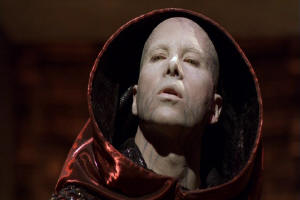
Sokar |
| In ancient Egypt, Sokar is really one of the more complex Egyptian gods to understand. He is often equated with Osiris, or as the resurrected Osiris though his scope stretches well beyond that over time. Even his name is shrouded in scholarly
controversy. One theory is that his name is derived from and based on the term sk r ("cleaning of the mouth") found in Coffin Text Spell 816 and a 12th dynasty papyrus. This term is used in the context of the Opening of the Mouth ceremony in which Sokar
does play a part. Another theory is that the etymology of the god's name comes from one of the Pyramid Texts where Osiris said, as a cry of help to his wife and sister, "Sy k ri", or hurry to me. Sokar was an ancient falcon god in the environs of
Memphis who perhaps was originally associated with craftsmanship. However, he came to be a god of the necropolis of that area and rose, in time, to considerable importance as a chthonic and afterlife deity. The Pyramid Texts frequently mention the god in
an afterlife context where the deceased king is said to be raised into the "henu barque" of Sokar and equated with Osiris, but only after the rise of Osiris to importance. The Pyramid Texts describe Sokar as a god active in the rebirth of the king and in
the ceremonies of confirmation and transfer of royal power. However, Sokar was associated with the Memphite god Ptah as the synchronistic Ptah-Sokar even before Sokar's association with Osiris. This was perhaps an easy link because Ptah too was a god of
craftsmanship. In fact, Sokar took Ptah's consort, Sekhmet as his own. In this form, Ptah-Sokar associates the wealth of the soil and its power of growth. |
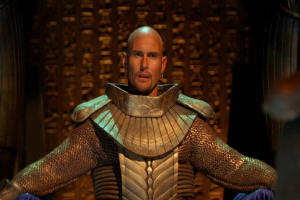
Heru'ur |
| Her-wer (Har-wer; G/R Haroeris) - "Great Heru/Heru the Elder" Heru in His most abstract, "original" form is known as a hawk, primarily a
divinity of sky, even on Predynastic pottery and other objects. The hawk of Her-wer came to be associated with the kingship and was depicted seated atop the ruler's name in the original "serekh" (palace facade) style of hieroglyphic rendering.
Her-wer is viewed as a brother, rather than son, of Wesir; His main opposite being Set, the Lord of the Red Land, and the storms in Her-wer's placid blue sky. Confusion of Her-wer's attributes with Heru-sa-Aset's led in
later times to both Netjeru being intertwined; however, in His earliest depictions, Her-wer is strictly a celestial and sometimes solar divinity; only later is He associated with the kings and with the myth cycle of the Wesirian cult. |
|
|

Osiris |
| Egyptian god of the underworld and of vegetation. Son of Nut and Geb. His birthplace was said to be Rosetau in the necropolis west of Memphis. Brother of Nephthys and Seth, and the brother and husband of Isis. Isis gave
birth to Horus after his death, having impregnated herself with semen from his corpse. Osiris was depicted in human form wrapped up as a mummy, holding the crook and flail. He was often depicted with green skin, alluding to his role as a god of
vegetation. He wore a crown known as the 'atef', composed of the tall conical white crown of Upper Egypt with red plumes on each side. Osiris had many cult centers, but the most important were at Abydos (Ibdju) in Upper Egypt, where the god's legend was
reenacted in an annual festival, and at Busiris (Djedu) in the Nile delta. One of the so-called "dying gods", he was the focus of a famous legend in which he was killed by the rival god Seth. At a banquet of the gods, Seth fooled Osiris into stepping
into a coffin, which he promptly slammed shut and cast into the Nile. The coffin was born by the Nile to the delta town of Byblos, where it became enclosed in a tamarisk tree. Isis, the wife of Osiris, discovered the coffin and brought it back. (The
story to this point is attested only by the Greek writer Plutarch, although Seth was identified as his murderer as early as the Pyramid era of the Old Kingdom.) Seth took advantage of Isis's temporary absence on one occasion, cut the body to pieces, and
cast them into the Nile. (In the Egyptian texts this incident alone accounts for the murder of Osiris.) Isis searched the land for the body parts of Osiris, and was eventually able to piece together his body, whole save for the penis, which had been
swallowed by a crocodile (according to Plutarch) or a fish (according to Egyptian texts). In some Egyptian texts, the penis is buried at Memphis. Isis replaced the penis with a reasonable facsimile, and she was often portrayed in the form of a kite being
impregnated by the ithyphallic corpse of Osiris. In some Egyptian texts, the scattering of the body parts is likened to the scattering of grain in the fields, a reference to Osiris's role as a vegetation god. 'Osiris gardens' - wood-framed barley
seedbeds in the shape of the god, were sometimes placed in tombs - and the plants which sprouted from these beds symbolized the resurrection of life after death. It was this legend that accounted for Osiris's role as a god of the dead and ruler of
the Egyptian underworld. He was associated with funerary rituals, at first only with those of the Egyptian monarch, later with those of the populace in general. The pharaoh was believed to become Osiris after his death. Although he was regarded as a
guarantor of continued existence in the afterlife, Osiris also had a darker, demonic aspect associated with the physiological processes of death and decay, and reflecting the fear Egyptians had of death in spite of their belief in an afterlife. Osiris
was also a judge of the dead, referred to as the 'lord of Maat' (i.e. of divine law). Legendary ruler of predynastic Egypt and god of the underworld. Osiris symbolized the creative forces of nature and the imperishability of life. Called the great
benefactor of humanity, he brought to the people knowledge of agriculture and civilization. The worship of Osiris, one of the great cults of ancient Egypt, gradually spread throughout the Mediterranean world and, with that of Isis and Horus, was
especially vital during the Roman Empire |
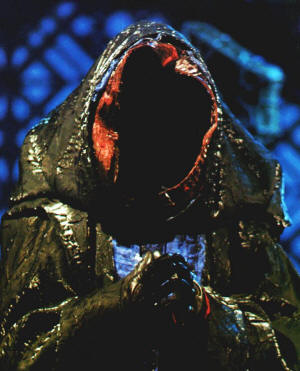
Anubis
|
| Egyptian god of the dead, represented as a black jackal or dog, or as a man with the head of a dog or jackal. His parents were usually given as Re in combination with either Nephthys or Isis. After the early period of
the Old Kingdom, he was superseded by Osiris as god of the dead, being relegated to a supporting role as a god of the funeral cult and of the care of the dead. The black colour represented the colour of human corpses after they had undergone the
embalming process. In the Book of the Dead, he was depicted as presiding over the weighing of the heart of the deceased in the Hall of the Two Truths. In his role as psychopomp he was referred to as the "conductor of souls". The Greeks later identified
him with their god Hermes, resulting in the composite deity Hermanubis. His principal sanctuary was at the necropolis in Memphis and in other cities. Anubis was also known as Khenty- Imentiu - "chief of the westerners" - a reference to the Egyptian
belief that the realm of the dead lay to the west in association with the setting sun, and to their custom of building cemeteries on the west bank of the Nile. |
| |
| |
| |



